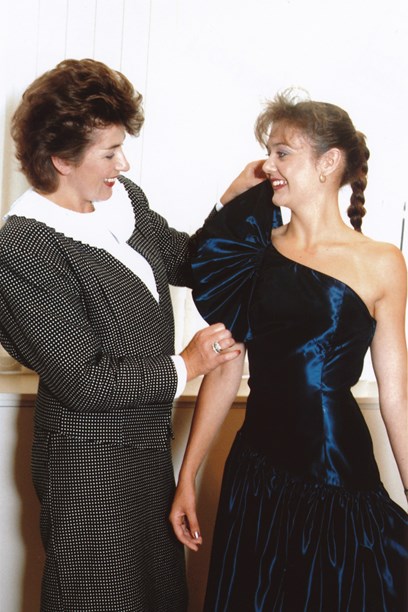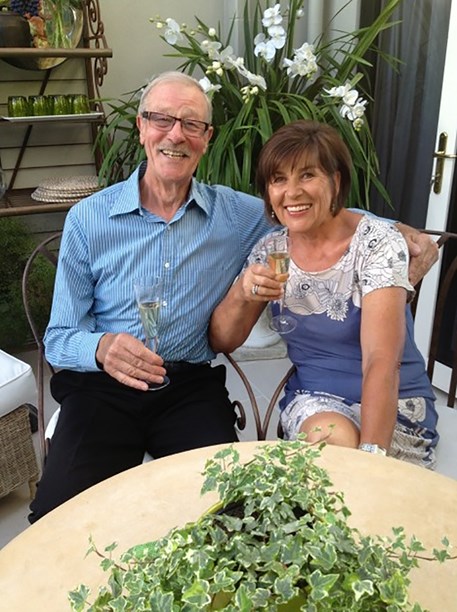Stories
Thornton Hall
1979-1993

Rural Marlborough and Paris are worlds apart but at the height of her career, farmer's daughter Isabel Harris found herself amongst fashion’s elite, choosing textiles for her thriving fashion business in New Zealand which she ran with her partner Brian Hall until 1993.
Growing up, Isabel had no idea that her mother had been a couturière having been trained by a Frenchwoman in Gisborne before marrying her farmer husband. Some of Isabel’s earliest memories are of her mother making hers and her sibling’s school uniforms. In what Isabel considered a painfully slow fashion, her mother carefully hand-sewed the hem of her skirt while she stood on the kitchen table. Later when Isabel's natural flair for design, trends and ideas surfaced her mother’s own sartorial roots were revealed.
Isabel moved to Auckland and found work in the merchandising department at George Courts. Here she met Brian Hall, who was working in the fashion industry. He and John Thorne had been at Desmond Reevely & Co when it was closed down in the mid 1960s and they took over some of the manufacturing licences for the young labels like Poppetwear and Career Girl. Brian invited Isabel to come in and apply her eye for design to their labels.
It wasn't long before they decided to open a new boutique, Hullabaloo. It was a bold move, but one that paid off as Hullabaloo became an icon of the 1970s.
But the decision to export into Australia in the late 1970s brought problems with the discovery of another label operating in Australia under the same name. To avoid confusion Isabel and Brian decided to sell under the name Thornton Hall for Australia only, but it quickly became clear that it would be less complicated to keep the same name for both businesses and they rebranded as Thornton Hall in 1979, keeping the name Hullabaloo only for the shop at 222 Queen Street.
Thornton Hall's first head office, showrooms, design department, cutting room and stockroom/dispatch was at 3 Lorne Street, occupying the entire floor through to the space above the Hullabaloo shop. But with a growing staff, they needed to expand. Isobel and Brian purchased a building in Wolf Street in the early 1980s, which they quickly outgrew. They had to buy another, much bigger, building in Union Street where there was space for a huge staff cafeteria and staff carparking.
With production factories in Auckland, Paeroa and Tauranga (as well as other factories that made garments on contract), plus 12 retail stores in New Zealand and two in Australia, Thornton Hall employed close to 1000 people.
Isabel speaks highly of her staff, including pattern cutter Jayne Gower. "Jayne had a natural ability, loved fashion and was passionate about all aspects of her work," Isabel says. "We enjoyed working together choosing fabrics and developing styles with me drawing rough sketches for her to use to produce the patterns. It takes a special skill to work from design sketches and constantly get the look right first off. Jayne had that ability."
The huge success of Hullabaloo and Thornton Hall marked Isabel Harris as one of the top designers of the 1970s and 1980s. She won Eve magazine’s fashion award in 1972 and Thornton Hall made a triumphant appearance at the 1982 Benson & Hedges Fashion Design Awards, scooping up four out of the five awards for which the label was nominated, including the Supreme Award. Isabel Harris was invited to judge the Benson and Hedges Awards in 1989 where she chose Annie Bonza as the Supreme Award winner.
The label’s success was to come at a commercial price though with some local manufacturers quick to copy the designs, and in an era where nearly everyone was a home-sewer it was a common occurrence for Isabel to see her designs replicated on the street. "I used to have girls come into the Hullabaloo shop with their mum and they would take a garment into the fitting room and get a tape measure out," says Isabel. "I would go and say 'Can I help you?' and they would be measuring up the garment in the fitting room. And the mother would turn it inside out and say 'Oh I can make it better than this. I’m not paying that much for this, I can make it.' So we not only got copied by the manufacturers but by home-sewers as well which was frustrating."
Eventually the copying got to a point where Isabel and Brian decided to take legal action in a case that made New Zealand law history in 1988. Thornton Hall fought a well-publicised case against Shanton Apparel who had blatantly copied a popular dress design of Isabel’s, manufacturing it in cheap material and selling it for a fraction of the price. It was the first copyright case of its kind as no relevant legislation existed at the time. The case was decided in Thornton Hall’s favour and contributed to the creation of the Copyright Act in 1994. Fashion is notorious for creating garments 'inspired' by others but this lawsuit was a wake-up call for many in the industry at the time.

Eventually the copying of their garments got to a point where Isabel and Brian decided to take legal action in a case that made New Zealand law history in 1988.
In 1987 Isabel won a competition to design a new uniform for Air New Zealand’s female staff. Although she expected to be able to further develop her proposed designs after winning the pitch, it turned out that Air New Zealand wanted them exactly as they were. The prize was an 'around the world' trip, a redundant idea for a couple who travelled each year to Premier Vision in Paris to buy fabrics and visit the fabric mills in Italy, Germany and France. Eventually a deal was negotiated with Air New Zealand who purchased the designs and the uniforms were put into production through Thornton Hall’s factories, eventually going into service in August 1987.
Isabel Harris designed the new uniform range for female shorthaul and longhaul cabin crew introduced in August 1987. Image © Air New Zealand.
During the 1980s Thornton Hall pioneered corporate dressing in New Zealand while always maintaining a strong commercial focus and keeping a keen eye on the current trends. Travel was essential to keep up with what was going on overseas and Isabel’s aesthetic had a definite European influence adapted for the New Zealand market. "The difficult thing is that you can never stop, you can’t rest back on your laurels because you’re working three years in advance if you’re buying fabrics and you’re creating original designs," says Isabel. "It sparks from the fabric and you work closely with the mills to see what is coming up. I used to go Premiere Vision in Paris and Karl Lagerfeld was there and I would think 'What the hell am I doing here? I’m a farmer’s daughter from New Zealand.' The first day I’d have a knot in my stomach but then I’d get a feel for the colours and go and see the presentation and then I’d pick up on what was coming in and think I could see garments in that." It was those instincts that served Isabel well throughout her design career and lent themselves to every aspect of the business.

Isabel Harris fitting a taffeta evening dress in the Thornton Hall showroom. Image © Isabel Harris.
Thornton Hall took on new business partners in the early 1990s and in 1993 Isabel and Brian made the decision to sell their shares. Thornton Hall was eventually closed in 1997.

Portrait of Brian Hall and Isabel Harris, 2015. Image © Brian Hall and Isabel Harris.
Isabel briefly continued her fashion career as a consultant for different knitwear companies before retiring completely after 26 years in the fashion industry. Reflecting on her prosperous run in fashion Isabel concedes that she was mostly too busy to really enjoy her success at the time, but since retiring has found great joy in meeting Hullabaloo and Thornton Hall fans who treasure her designs to this day.
Text by Evelyn Ebrey. Banner image of Thornton Hall boutique in Sydney's Imperial Arcade. Image © Isabel Harris and Brian Hall.
Last published November 2015.